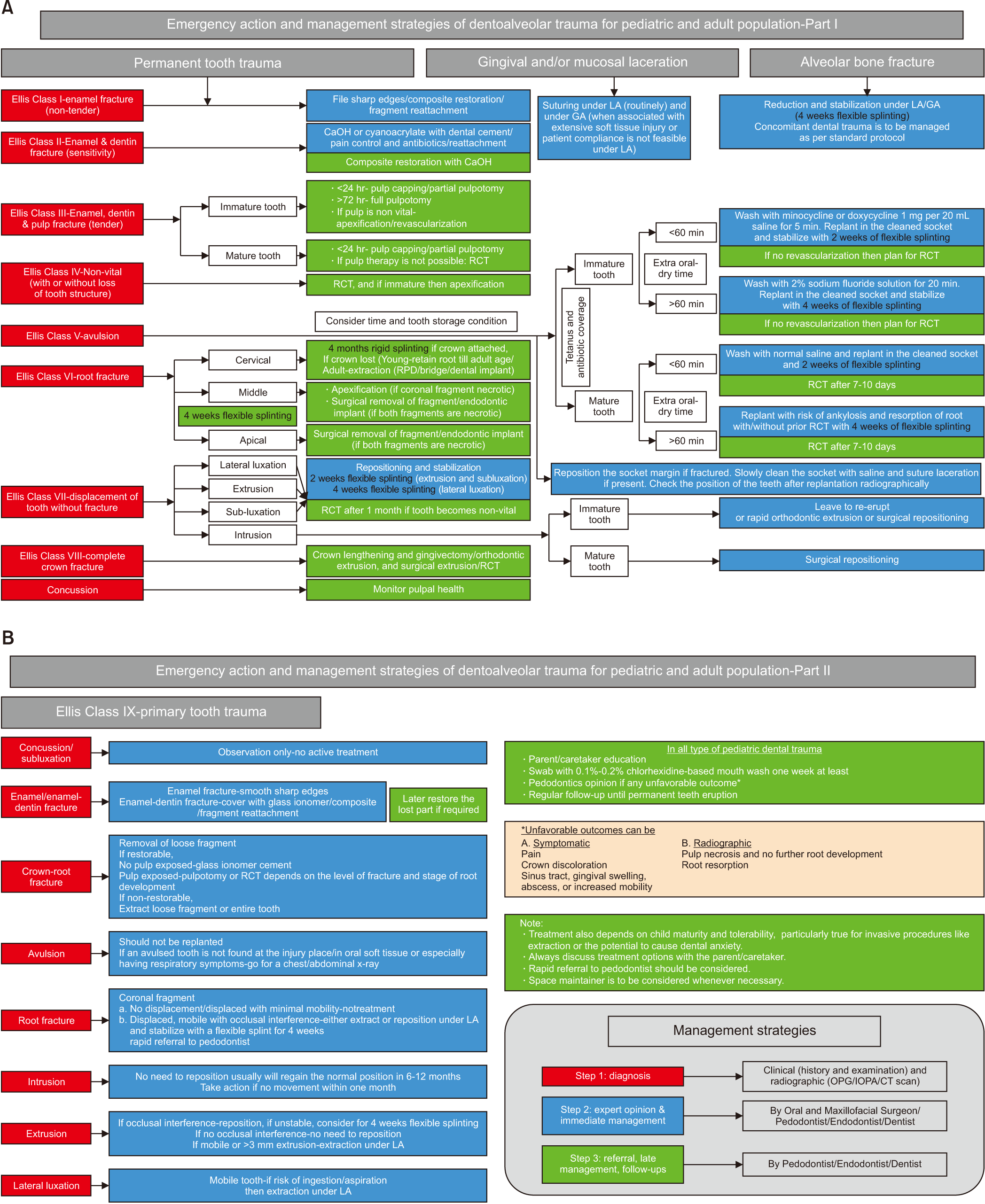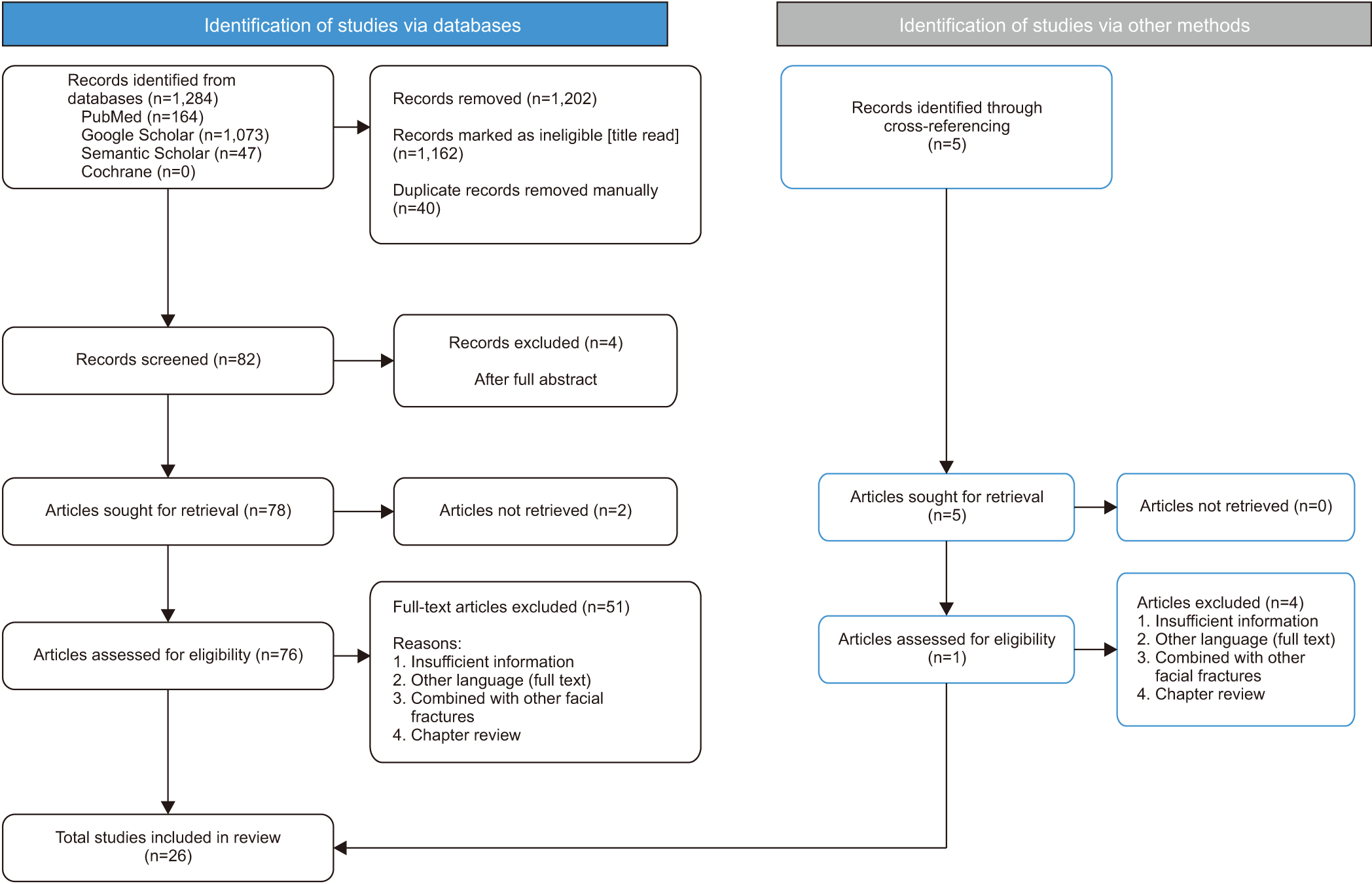Abstract
Notes
Authors’ Contributions
S.B. and B.L. contributed to formulating the research question, protocol development, literature search, study selection, data extraction, and manuscript writing. R.A. contributed to data synthesis and manuscript writing. J.K., A.A., A.J.R., and M.Y. participated in the study design and coordination and helped to draft the manuscript. All authors read and approved the final manuscript.
References
Fig. 2

Table 1
Table 2
| No. | Study | No. of cases | Age (yr) | Sex (M/F) | Study type | Etiology | Jaw site | Dental trauma | Immediate dental management | Radiographs | Injury to splinting time (hr) | Type of splint | Type of anesthesia | Duration of splinting (wk) | Late dental management (since trauma) | Unfavorable outcome | Follow-up duration (mo) |
|---|---|---|---|---|---|---|---|---|---|---|---|---|---|---|---|---|---|
| 1 | Khan et al.16 (2020) | 1 | 9 | M | CR | Fall (first floor) | Upper anterior | Intrusion (11, 21, 22) | Reposition | OPG | 12 | Composite resin-bonded (semi-rigid) | LA | 4 | Not done | None | 2 |
| Avulsion (12) | No replantation (loss) | ||||||||||||||||
| 2 | Quinto et al.17 (2022) | 1 | 10 | M | CR | Fall (own height) | Lower anterior | NM | NM | NCCT & PA skull | NM | Circummandibular cerclage with steel wire (rigid) | GA | 12 | RCT, 90 days | Abscess (submental) | 42 |
| 3 | Thakur and Thakur18 (2021) | 1 | 11 | M | CR | RTA | Lower anterior | Avulsion (11, 12, 21, 22, 23, 24, 65, 41) | No replantation (alveolar sockets damage) | NCCT & OPG | 24 | Composite resin bonded (semi-rigid) | LA | 4 | RPD after 42 days | NM | NM |
| Luxation (31, 42) | Reposition | ||||||||||||||||
| 4 | Nilesh et al.19 (2020) | 1 | 12 | M | CR | Fall (bicycle) | Lower anterior | NM | NM | OPG | NM | Vacuum-formed (rigid) | LA | 3 | NM | NM | 1 |
| 5 | Patel and Bukhari20 (2020) | 1 | 4 | M | CR | Fall (during playing) | Lower anterior | None | NM | OPG, IOPA | NM | Interdental composite (rigid) | LA | 4 | NM | None | 6 |
| 6 | Vidhya R et al.21 (2017) | 1 | 7 | F | CR | RTA | Upper anterior | NM | NM | OPG | NM | Open-cap acrylic splint cemented (rigid) | LA | 3 | NM | NM | NM |
| 7 | Sreejith et al.22 (2015) | 1 | 2 | F | CR | Fall (window height) | Lower anterior | NM | NM | Occlusal radiograph | NM | Acrylic splint fixation (rigid) | GA (associated soft injury) | 3 | NM | NM | <1 |
| 8 | Sangeetha et al.23 (2014) | 1 | 10 | M | CR | Fall (during cricket playing) | Upper posterior fracture of interdental bone between 25 and 26 | Avulsion (21, 24) | Replantation | OPG | 2 | Modified acrylic cap (rigid) | LA | 2 | RCT, 60 days | Replacement resorption of root | 36 |
| Luxation (22) | Reposition | ||||||||||||||||
| Extrusion (25, 26, 31, 32, 41) | Fiber splint | ||||||||||||||||
| 9 | Yonezawa et al.24 (2013) | 1 | 11 | F | CR | Fall (while playing) | Upper anterior | Intrusion (11) | Reposition | OPG & IOPA | NM | Open reduction and internal fixation using titanium micromesh plate (rigid) | LA | 20 | RCT, 3 days | None | 12 |
| 10 | De Rossi et al.25 (2009) | 1 | 12 | M | CR | Fall (bicycle) | Upper anterior | Enamel fracture (11) | Composite restoration. | IOPA & lateral radiograph | 10 | Composite resin with orthodontic wire (semi-rigid) | LA | 36 (patient failed to keep up with treatment plan) | RCT, 15 days | Loss of labial alveolar bone and gingival recession | 24 |
| 11 | Saito et al.26 (2009) | 1 | 12 | F | CR | Fall (bicycle) | Upper anterior | Luxation (11, 21) | Reposition | NM | NM | Stainless steel orthodontic wire, with cyanoacrylate ester (semi-rigid) | LA | 4 | RCT, 15 days | None | 24 |
| Avulsion (12, 22) | No replantation | ||||||||||||||||
| 12 | Koyuturk et al.27 (2008) | 1 | 12 | F | CR | Fall (slip in bathroom) | Upper anterior | Crown fracture (11, 21) | Composite restoration | OPG & IOPA | <2 | Composite resin bonded (semi-rigid) | LA | 4 | RCT, 28 days | NM | 36 |
| Intrusion (11, 12, 13), Luxation (11, 12, 13) | Reposition | ||||||||||||||||
| Avulsion (14) | Replantation | ||||||||||||||||
| 13 | Sahin et al.28 (2008) | 1 | 9 | F | CR | Fall (during playing) | Upper anterior | Avulsion (11, 21) | Replantation | NM | 0.75 | Composite resin bonded (semi-rigid) | LA | 6 | RCT, 150 days | None | 5 |
| 14 | Das et al.29 (2007) | 1 | 11 | M | CR | Fall (first floor) | Lower anterior | Avulsion (21, 22, 63) | No replantation, RPD after healing | NCCT, PNS & OPG | NM | Composite resin bonded (semi-rigid) | LA | 3 | NM | NM | NM |
| Enamel fracture (12, 32, 41) | Composite restoration | ||||||||||||||||
| 15 | Prabhakar et al.30 (2006) | 1 | 8 | M | CR | Blast (scooter silencer) | Upper anterior | NM | NM | OPG | NM | Acrylic splint with wiring (open-cap) (rigid) | GA (associated soft injury) | 3 | NM | None | 2 |
| 16 | Martins and Fávaro31 (2005) | 1 | 2 | F | CR | Fall (bed) | Upper anterior | NM | NM | NM | NM | Immobilization with suturing (2-0 chromic gut suture) (semi-rigid) | GA | 2 | Not required | None | 12 |
| 17 | Martins et al.32 (2004) | 1 | 8 | F | CR | During swimming | Upper anterior | Avulsion (21, 53) | No Replantation | IOPA | 7 | Acrylic resin (rigid) | LA | 4 | NM | Resorption of tooth | 36 |
| Luxation (11, 12) | Reposition | ||||||||||||||||
| 18 | Sheroan and Roberts33 (2004) | 1 | 9 | F | CR | Fall (during basket playing) | Upper anterior and posterior | Avulsion (16, 55, 54, 12, 13, 21, 22, 64, 65, 24, 25, 26) | Replantation (12, 22) | OPG | NM | Stabilized with silk suture material and composite resin bonded (semi-rigid) | GA (associated soft injury) | NM | RCT, 21 days | One extraction | 9 |
(M: male, F: female, CR: case report, RTA: road traffic accident, NM: not mentioned, RPD: removable partial denture, OPG: orthopantomogram, NCCT: non-contrast computed tomography, PA: posterior-anterior, IOPA: intra oral periapical, PNS: paranasal sinus, LA: local anesthesia, GA: general anesthesia, RCT: root canal treatment)
Table 3
| No. | Study | No. of cases | Age (yr) | Sex (M/F) | Study type | Etiology | Jaw site | Dental trauma | Immediate dental management | Radiographs | Injury to splinting time (hr) | Type of splint | Type of anesthesia | Duration of splinting (wk) | Late dental management (since trauma) | Unfavorable outcome | Follow-up duration (mo) |
|---|---|---|---|---|---|---|---|---|---|---|---|---|---|---|---|---|---|
| 1 | Dhusia et al.34 (2021) | 1 | 29 | M | CR | Fall (under influence of alcohol) | Upper anterior | Avulsion (21, 22) | Replantation | None | Immediate | Erich’s arch bar with wire (rigid) | LA | 6 | RCT, 6 wk | NM | 6 |
| 2 | Firstyananda and Sjamsudin 35 (2018) | 1 | 67 | F | CR | Fall (slip in bathroom) | Upper anterior | Enamel fracture (11, 21, 22) | Selective grinding | OPG | NM | Composite resin bonded (rigid) | LA | 6-7 | NM | NM | NM |
| 3 | Ali et al.36 (2017) | 1 | 20 | M | CR | Sports | Upper anterior | Extrusion (11, 21) | Repositioning | IOPA | 24 | Erich’s arch bar with wire (rigid) | LA | NM | NM | NM | NM |
| 4 | Serra-Pastor et al.37 (2016) | 1 | 25 | F | CR | Fall (NM) | Upper anterior | Crown fracture (11, 12, 21, 22) | IOPA & CBCT | NM | Composite resin bonded (semi-rigid) | LA | 3 | RCT & ceramic crown, 3 wk | None | 24 | |
| Luxation (21) | Repositioning of luxated teeth | ||||||||||||||||
| 5 | Faus-Matoses et al.38 (2014) | 1 | 20 | M | CR | Fall | Upper anterior | Intrusions (12, 11, 21) | Repositioning | CBCT, OPG | 4 | Wire-composite (semi-rigid) | LA | 4 | RCT, 3 wk | NM | 60 |
| Crown fractures (11, 21) and crown-root fracture (22) | Ceramic crown | ||||||||||||||||
| 6 | Nyárády et al.39 (2010) | 6 (3 included) | 28-71 | M 2, F 1 | CS | NM | Upper anterior | NM | OPG | NM | Bone screw stabilization (rigid) | GA 1, LA 2 | 12 | RPD (3 cases) | None | NM | |
| 7 | Al-Hadad et al.40 (2009) | 1 | 21 | M | CR | Assault | Posterior maxilla | NM | NM | NM | NM | Custom-made arch bars and intermaxillary fixation (rigid) | NM | 4 | NM | NM | NM |
| 8 | Finucane et al.41 (2004) | 1 | 13 | M | CR | Fall (NM) | Lower anterior | NM | NM | NM | 48 | Composite resin bonded (rigid) | GA | 2 | RCT, 12 wk | None | 3 |
Table 4
(CR: case report, CS: case series, RTA: road traffic accident, NM: not mentioned, OPG: orthopantomogram, IOPA: intra oral periapical, CBCT: cone-beam computed tomography, NCCT: non-contrast computed tomography, PNS: paranasal sinus view, PA: posterior-anterior, MMF: maxillomandibular fixation, LA: local anesthesia, GA: general anesthesia, RPD: removable partial denture)




 PDF
PDF Citation
Citation Print
Print




 XML Download
XML Download